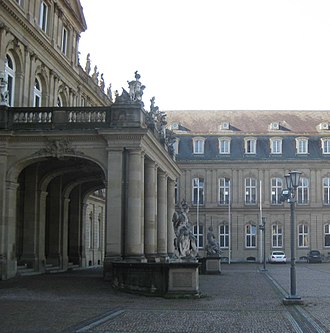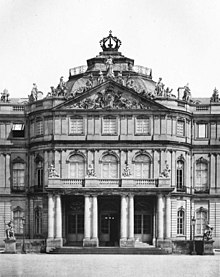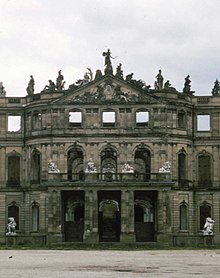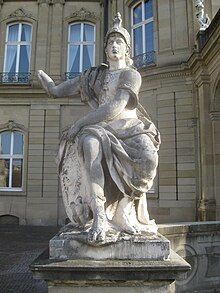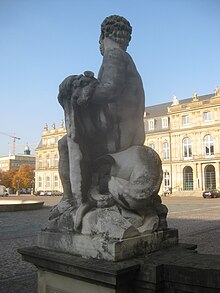Hercules and Minerva (Schlossplatz Stuttgart)
Hercules and Minerva are two colossal statues that flank the entrance portico of the main wing of the New Palace in Stuttgart on stone pedestals . In 1759, Pierre François Lejeune, the first sculptor of the Württemberg Duke Carl Eugen , created these statues of the divine hero Hercules and the goddess Minerva.
location
A 14-meter-wide portico porch forms the entrance and the access ramp to the main wing of the New Palace ( Corps de Logis ). It is flanked by larger than life figures of the ancient deities Minerva and Hercules .
base
The front end is supported by four double columns. The bases of the outer columns merge into parapet walls, which, like arms, open at ground level in a quarter circle towards the Schlossplatz. The ends of the walls are connected to the sandstone plinths of the two figures of gods. The cube-shaped base with a profiled base and cover plate have rectangular relief panels on the three free sides with an area-filling pattern of intertwined chain bands. They take up the relief pattern of the parapet walls and the pedestal of the portico. The statues of the gods are flanked by two slender, two-armed candelabra that are offset diagonally forward.
Still images
The larger-than-life figures of gods were created in 1759 by the Belgian sculptor Pierre François Lejeune (1721–1790), who was appointed to Stuttgart by Duke Carl Eugen in 1753 and, as Premier Sculpteur (first sculptor), played a decisive role in the visual design of the ducal buildings. The group of figures unites the divine hero Hercules, the son of Zeus and a mortal, with the goddess Minerva, his half-sister and protector. As part of the castle's figure program, which is dedicated to the representation of the prince and his country, the gods personify the most important princely virtues of strength and strategy.
The sandstone figures designed as sitting figures rest on thick square plinths . The figures face the visitors who are going to the palace via Schlossplatz.
The plinth of Hercules is labeled: “Based on the original by PF Lejeune / renewed by the sculptor A. Göckle i. J. 1909 ". According to Frank Thomas Lang, both stills were replaced by copies, he does not state in which year. The statues remained largely intact except for their heads from the destruction of World War II.
| → Historical photos |
|
|
Minerva
When designing Minerva (the Greek Athena), Lejeune was based on the model of Athena Parthenos , the Athena statue of Phidias in the Parthenon temple in Athens. Although this has been lost, its appearance has been handed down through replicas and descriptions.
The seated, belligerent goddess wears a short-sleeved armor with a Medusa head on her chest, plus a pleated garment that covers the lower body but leaves the right leg free up to the knee, and Roman lace-up sandals on her feet. Her headgear is a helmet with a sphinx figure above the head and griffin reliefs on the sides. With her left arm she reaches for the Aegis shield standing upright on the ground on her right, which bears the head of Medusa with its serpentine crown . There is an owl by the shield as a symbol of the goddess of wisdom. The now amputated right hand originally enclosed the now lost lance of Minerva.
Hercules
Hercules, a plump, muscular middle-aged man with a thick head of curls and a full curly beard, is enthroned on the back of the Hydra, a fat, dolphin-like monster with seven heads and a lizard tail. The hero is leaning on his mighty club with both arms, his gaze turned sideways to the sky, and crushing one of the Hydra's heads with his left foot. The skin of the Nemean lion and head lies over his left arm as a sign of his successful first heroic work. The fur also covers the pubic part of the otherwise unclothed hero.
The still image shows a snapshot of Hercules' heroic battle with the Hydra, his second heroic work. While most artists depicted Hercules standing and eye to eye with the monster, Lejeune chose the sitting position of the conqueror, which makes it all the easier to cut off the heads of the Hydra. (Perhaps Lejeune decided on the seated position for reasons of statics and in analogy to the enthroned posture of Minerva.) One is undecided whether the hero is temporarily tired and whether his view of the sky expresses his perplexity as to how to continue with the hydra should proceed. In any case, he will immediately cut off her mortal heads and then the immortal head, burn the decapitated necks with the torch and thus seal the destruction of the Hydra.
literature
- Karl Büchele: Stuttgart and its surroundings for locals and foreigners. Stuttgart 1858, page 23, pdf .
- Johann Andreas Demian: Oddities of Stuttgart and its surroundings. A guide especially for strangers. With a plan of Stuttgart. Stuttgart: Ebner, 1814, page 22, pdf .
- Walther-Gerd Fleck; Franz Josef Talbot: New Castle Stuttgart: 1744 - 1964. Braubach: German Castle Association, 1997.
- Christian von Holst (editor): Swabian classicism between ideal and reality, catalog. Stuttgart 1993, page 448.
- Frank Thomas Lang: Pierre François Lejeune: Carl Eugens court sculptor and academy teacher. Born in Brussels 275 years ago. In: Schlösser Baden-Württemberg, 1996, issue 1, pages 10-13.
Web links
Footnotes
- ↑ #Lang 1996 , page 12.
- ↑ #Holst 1993.1 .
- ↑ #Demian 1814 .
- ↑ #Fleck 1997 , page 92nd
- ↑ The reading “i. J. 1909 "=" in 1909 "is uncertain.
- ↑ #Lang 1996 , page 12.
Coordinates: 48 ° 46 '40.9 " N , 9 ° 10' 54.3" E
